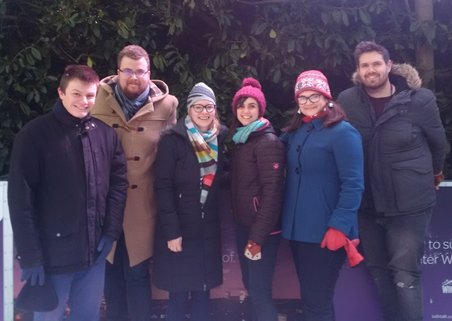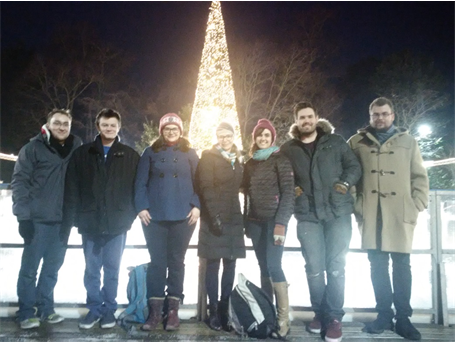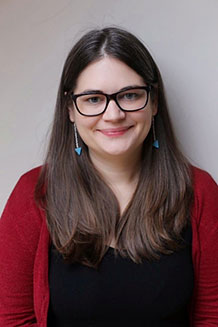Dr Meghan Halse
Senior Lecturer in Chemistry
01904 322853
Email: meghan.halse@york.ac.uk
Research
My research interests centre on the development of new nuclear magnetic resonance (NMR) and magnetic resonance imaging (MRI) methods with a particular focus on the use of hyperpolarisation and low-cost, portable instrumentation to open up new applications.
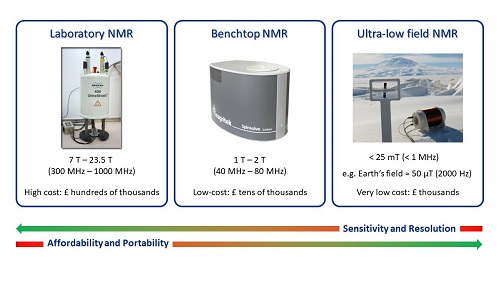
Nuclear magnetic resonance (NMR) is an invaluable tool for applications ranging from chemical analysis to clinical diagnosis. The power of NMR lies in the wealth of molecular-level information available but it is limited by low sensitivity. This can be overcome by using strong magnetic fields, but high-field NMR instruments are large and expensive. There are many applications where it would be preferable to be able to use a lower-cost and more portable instrument but this is only feasible if the issue of low sensitivity can be overcome.
Hyperpolarisation methods increase the sensitivity of NMR by generating nuclear spin population differences that are orders of magnitude larger than what we get under normal circumstances. This leads directly to an increase in the observed NMR signal strength. In our work, we focus primarily on parahydrogen induced polarisation (PHIP). Parahydrogen (p-H2) is a special form of hydrogen gas that exists in a so-called pure nuclear singlet state. In itself p-H2 provides no NMR signal, but when it is involved in a chemical reaction p-H2 can generate NMR signals that are amplified by factors of up to tens of thousands. This effect does not depend on a strong magnetic field and so can be combined with low-field and low-cost detectors.
Researchers at York, led by Prof Simon Duckett, have recently developed a new approach to parahydrogen hyperpolarisation called signal amplification by reversible exchange (SABRE). SABRE is completely reversible so it can be applied multiple times to the same sample without changing the chemical identity of the target molecule. This transformative technique has led to the establishment of the Centre for Hyperpolarisation in Magnetic Resonance (CHyM) at the University of York.
Hyperpolarised Benchtop NMR Spectroscopy
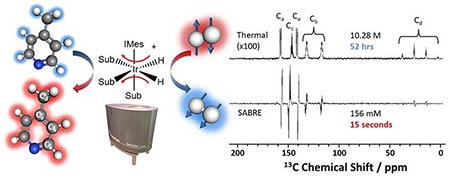
Signal amplification by reversible exchange (SABRE), a catalytic method for generating NMR hyperpolarisation, enables high-sensitivity benchtop (1 T) 13C and 1H NMR spectroscopy.
The SABRE hyperpolarisation approach is attractive for use with low-cost and portable benchtop NMR spectrometers because the NMR signal enhancements that generated by SABRE are independent of the strength of the magnetic field inside the NMR spectrometer that is used for detection. Therefore signal increases by factors of >10,000 can be observed, even in weak detection fields. One of the main research areas in my group involves the integration of SABRE hyperpolarisation with benchtop NMR spectrometers, which typically have magnetic fields of 1 - 2 T, with a view to developing and optimising this technique for applications in industry and/or human health. This work is funded by the Engineering and Physical Sciences Research Council (EPSRC) and is a collaboration with Professor Simon Duckett at University of York and Dr Alison Nordon at the University of Strathclyde in Glasgow.
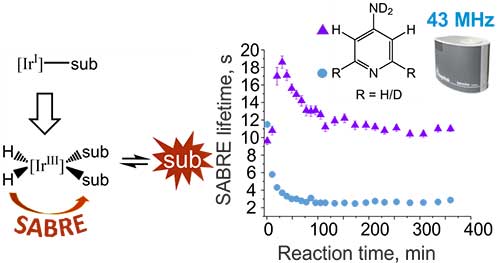
SABRE-enhanced benchtop NMR can be used for analytical applications such as reaction monitoring.
Ultra-low-field NMR and MRI
At the heart of the SABRE process is a transfer of NMR signal from p-H2 to the target molecule in a magnetic field that is more than 1000 times weaker than a typical NMR magnet. This magnetic field range is often referred to as the zero-to-ultra-low-field (ZULF) regime. In this project, we are interested in directly observing the generation of SABRE hyperpolarisation in situ (i.e. under the same experimental conditions as it is generated) in order to better understand and thus optimise this process. In addition, NMR detection in the ZULF regime opens the door to truly low-cost and portable NMR and MRI solutions in the future. This work is funded by the Engineering and Physical Sciences Research Council (EPSRC) through a New Investigator Award.

Hyperpolarisation allows 1H NMR to be performed on very small volumes of analyte in the Earth’s field (~50 µT), which is 200,000 times weaker than a standard NMR magnet.
NMR reaction monitoring with in situ photochemistry
Another research area in my group involves the development of a time-resolved NMR spectroscopy method using laser initiation and NMR detection with p-H2 hyperpolarisation. In contrast to conventional p-H2-enhanced experiments, where the chemical reaction involving p-H2 occurs asynchronously (randomly) and the reaction time is long (seconds) on the timescale of the coherent evolution of the NMR signals (µs – ms), here we initiate the reaction with p-H2 photochemically using a 10 ns laser pulse. This coherent initiation step allows us to observe the build-up of parahydrogen hyperpolarisation on a microsecond timescale. The goal of this work is to develop a robust time-resolved NMR tool for measuring reactivity on micro-to-millisecond timescales. More recently, we have begun to expand this work for detection using a benchtop NMR spectrometer.
This project is a collaboration with Professor Simon Duckett and Professor Robin Perutz.
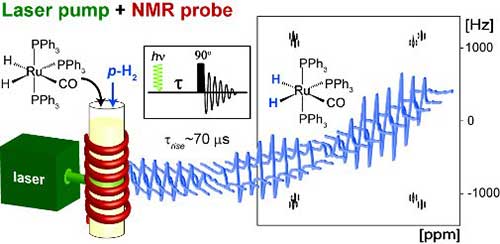
Time-resolved NMR spectroscopy with p-H2 hyperpolarisation
Group members
Current group members
Meghan Halse
Meghan joined the York Chemistry department in 2013 following periods of work and study at the University of New Brunswick in Canada, Victoria University of Wellington in New Zealand and the CNRS in Lyon, France. Meghan is a physical chemist and NMR spectroscopist who is interested in developing new NMR and MRI instruments and methods. Meghan’s research group focuses in particular on the development of portable, low-field NMR and MRI devices that can be used for applications outside of the traditional laboratory environment. Current research projects use parahydrogen-based hyperpolarisation methods to increase the sensitivity of low-field NMR in order to enable new applications. In addition to her research, Meghan teaches the fundamentals of magnetic resonance and a range of maths and physical chemistry topics at an undergraduate level.
Ana Silva Terra
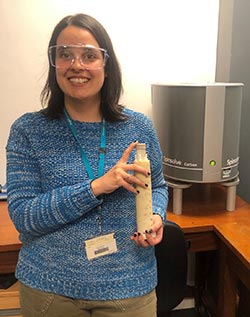
Ana is a PhD student working under the supervision of Meghan Halse. Ana joined the group in 2021 after completing an MSc in Chemistry at the Universidad de la República (Uruguay). For her PhD project, Ana is working on developing analytical applications of SABRE as a parahydrogen derived hyperpolarisation method in benchtop NMR, with particular focus on quantitative methods.
James McCall
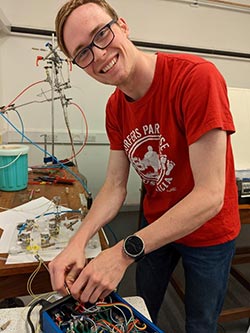
James is a PhD student working under the supervision of Meghan Halse. James joined the group in 2020 for an MChem project at the University of York and has stayed on for his PhD. In his project James is working on building instrumentation to study the SABRE process in-situ at low field, including a field-switching and hydrogen-bubbling apparatus. This instrumentation may also allow the targeting of alternative nuclei such as 13C and 19F for in-situ hyperpolarisation.
Izzy Hehir
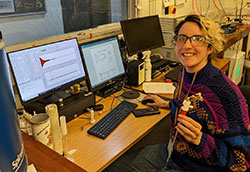
Izzy is a PhD student working under the supervision of Meghan Halse as part of the Hyperpolarised NMR Solutions beyond the Laboratory (HyperSoL) project. Izzy joined the group in 2023 after completing an MChem at the University of York. For their PhD project, Izzy is working on the implementation of in situ SABRE hyperpolarisation on a benchtop NMR spectrometer.
Daniel Taylor
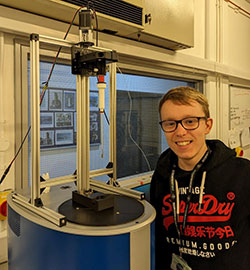
Dan joined the group in April 2023 as a post-doctoral research associate working on the Hyperpolarised NMR Solutions beyond the Laboratory (HyperSoL) project. He completed his undergraduate and postgraduate studies at The University of Manchester, with his PhD thesis entitled “New Methods in Parahydrogen Hyperpolarised Nuclear Magnetic Resonance Spectroscopy”. His research interests include parahydrogen hyperpolarisation instrumentation development, NMR pulse sequence design, and the application of hyperpolarisation methods to overcome NMR sensitivity limitations. Dan is currently working on the development of portable NMR instrumentation with in situ hyperpolarisation.
Publications
Selected publications
Enhancing 19F benchtop NMR spectroscopy by combining parahydrogen hyperpolarisation and multiplet refocusing
Ana I. Silva Terra, Matheu Rossetto, Claire L. Dickson, George Peat, Dusan Uhrin and Meghan E. Halse, ACS Measurement Science Au, 2023, 3, 1, 73-81. DOI: https://doi.org/10.1021/acsmeasuresciau.2c00055
SHARPER-enhanced benchtop NMR: improving SNR by removing couplings and approaching natural linewidths
C. L. Dickson, G. Peat, M. Rossetto, M. E. Halse, and D. Uhrin, Chem. Comm., 2022, 58, 5534-5537. DOI: https://doi.org/10.1039/d2cc01325h
In situ SABRE hyperpolarisation with Earth’s field NMR detection
F. Hill-Casey, A. Sakho, A. Mohammed, M. Rossetto, F. Ahwal, S.B. Duckett, R.O. John, P.M. Richardson, R. Virgo, M. E. Halse, Molecules, 2019, 24, 4162. DOI: 10.3390/molecules24224126
Rapid 13C NMR Hyperpolarization delivered from para-hydrogen enables the low concentration detection and quantification of sugars
Richardson, P. M., Iali, W., Roy, S. S., Rayner, P. J., Halse, M. E. & Duckett, S., Chemical Science, 2019, 10, 10607. DOI: 10.1039/C9SC03450A
Towards measuring reactivity on micro-to-millisecond timescales with laser pump, NMR probe spectroscopy, M.E. Halse, B. Procacci, R. N. Perutz, and S. B. Duckett, Faraday Discussions, 2019, 220,28-44. DOI: 10.1039/C9FD00039A
Reaction monitoring using SABRE-hyperpolarized benchtop (1 T) NMR spectroscopy
Semenova, O., Richardson, P. M., Parrott, A., Nordon, A., Halse, M. E., and Duckett, S., Analytical Chemistry. 2019, 91, 6695-6701. DOI: 10.1021/acs.analchem.9b00729
Hyperpolarised 1H-13C benchtop NMR spectroscopy
A.D. Robinson, P.M. Richardson, and M.E. Halse, Applied Sciences, 2019, 9, 1173. DOI: 10.3390/app9061173
Quantification of hyperpolarisation efficiency in SABRE and SABRE-Relay enhanced NMR spectroscopy
P. M. Richardson, R. O. John, A. J. Parrott, P. J. Rayner, W. Iali, A. Nordon, M. E. Halse, and S. B. Duckett, Physical Chemistry Chemical Physics, 2018, 20, 26362-26371. DOI: 10.1039/C8CP05473H
Quantitative In-situ Monitoring of Parahydrogen Fraction Using Raman Spectroscopy
A. J. Parrott, P. Dallin, J. Andrews, P. M. Richardson, O. Semenova, M. E. Halse, S. B. Duckett, and A. Nordon, Applied Spectroscopy, 2019, 73, 88-97 DOI: 10.1177/0003702818798644
SABRE hyperpolarisation enables high-sensitivity 1H and 13C benchtop NMR spectroscopy
P. M. Richardson, A. J Parrott, O. Semenova, A. Nordon, S. B. Duckett, M. E. Halse, Analyst, 2018, 143, 3442-3450. DOI: 10.1039/C8AN00596F
A simple hand-held magnet array for efficient and reproducible SABRE hyperpolarisation using manual sample shaking
P. M. Richardson, S. Jackson, A. J Parrott, A. Nordon, S. B. Duckett, M. E. Halse, Magn. Reson. Chem., 2018, 56, 641-650. DOI: 10.1002/mrc.4687
Coherent evolution of parahydrogen induced polarisation using laser pump, NMR probe spectroscopy: Theoretical framework and experimental observation
M. E. Halse, B. Procacci, S. L Henshaw, R. N. Perutz, S. B. Duckett, J. Magn. Reson., 2017, 278, 25-38. DOI: 10.1016/j.jmr.2017.03.005
Photochemical pump and NMR probe to monitor the formation and kinetics of hyperpolarized metal dihydrides.
B. Procacci, P. M. Aguiar, M. E. Halse, R. N. Perutz, S. B. Duckett, Chem. Sci., 2016, 7, 7087-7093. DOI: 10.1039/C6SC01956K
Macroscopic Nuclear Spin Diffusion Constants of Rotating Polycrystalline Solids from First-Principles Simulation
M E Halse, A Zagdoun, J-N Dumez and L Emsley, J. Magn. Reson., 2015, 254, 48-55. DOI: 10.1016/j.jmr.2015.02.016
Direct observation of hierarchical protein dynamics.
J R Lewandowski, M E Halse, M Blackledge and L Emsley, Science, 2015, 348, 578-58. DOI: 10.1126/science.aaa6111
Photochemical pump and NMR probe: Chemically created NMR coherence on a microsecond time scale.
O Torres, B Procacci, M E Halse, R W Adams, D Blazina, S B Duckett, B Eguillor, R A Green, R N Perutz and D C Williamson, J. Am. Chem. Soc., 2014, 136, 10124- 0131. DOI: 10.1021/ja504732u
High-resolution 1H solid-state NMR spectroscopy using windowed LG4 homonuclear dipolar decoupling.
M E Halse, J Schlagnitweit and L Emsley, Isr. J. Chem., 2014, 54, 134-146.
Improved phase-modulated homonuclear dipolar decoupling for solid-state NMR spectroscopy from symmetry considerations.
M E Halse and L Emsley, J. Phys.Chem. A., 2013, 117, 5280-5290.
Quasi-equilibria in reduced Liouville spaces.
M E Halse, J-N Dumez and L Emsley, J. Chem. Phys., 2012, 136, 224511.
A common theory for phase-modulated homonuclear decoupling in solid-state NMR.
M E Halse, and L Emsley, Phys. Chem. Chem. Phys., 2012, 14. 9121-9130.
A first-principles description of proton-driven spin diffusion.
J-N Dumez, M E Halse, M Butler and L Emsley, Phys. Chem. Chem. Phys., 2012, 14, 86-89.
Quantitative analysis of Earth's field NMR spectra of tightly coupled heteronuclei.Quantitative analysis of Earth's field NMR spectra of tightly coupled heteronuclei.
M E Halse, P T Callaghan, B Feland and R E Wasylishen, J Magn. Reson., 2009, 200, 88-94.
A dynamic nuclear polarisation strategy for multidimensional Earth's field NMR spectroscopy.
M E Halse and P T Callaghan, J. Magn. Reson., 2008, 195, 62-168.
Alumni
Alumni

Group photo December 2022

Group photo November 2021
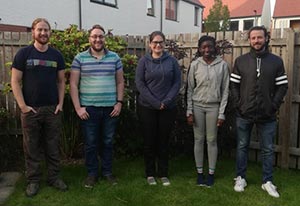
Group photo September 2020
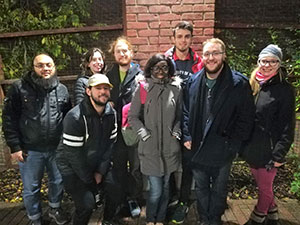
Group photo - December 2018
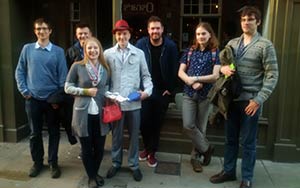
Group photo - June 2017
Former Group Members
Robin Virgo

Robin started his PhD under the joint supervision of Meghan Halse and Simon Duckett in October 2015. He was unable to complete his studies due to ill health and sadly passed away in December 2017. His good humour and endless supply of trivia knowledge are very much missed in the group.
Aminata Sakho
Aminata successfully defended her PhD in January 2023. Aminata’s PhD was carried out as part of the European Zero and Ultra-Low Field (ZULF) NMR innovative training network. Aminata’s thesis involved the development of novel chemical systems for signal amplification by reversible exchange (SABRE) using ZULF detection.
Matheus Rossetto
Matheus successfully defended his PhD in December 2022. During his PhD, Matheus developed instrumentation and methods for in situ SABRE hyperpolarisation of 1H and 19F with Earth’s field NMR detection.
Alastair Robinson
Alastair successfully defended his PhD thesis in December 2022. Alastair’s research involved the development of thermal and photochemical reaction monitoring using parahydrogen-enhanced benchtop NMR spectroscopy.
Olga Semenova
Olga successfully defended her PhD thesis in September 2019. Olga’s research concerned the development of low-field NMR instrumentation for industrial use. In particular she developed reaction monitoring methods using a benchtop (1 T) NMR spectrometer.
Fraser Hill-Casey
Fraser worked as a post-doctoral researcher in the group from 2018-2020 as part of an EPSRC-funded project. His project involved the design and fabrication of novel low cost scientific instruments including parahydrogen generators, automated polarisation transfer systems and low magnetic field NMR detectors for in situ parahydrogen hyperpolarisation and detection.
Peter Richardson
Peter worked in the group from 2015 to 2019 as a post-doctoral researcher working on a collaborative project led by Simon Duckett and Meghan Halse in York and Alison Nordon at the University of Strathclyde in Glasgow. Peter’s research interests lie in the synthesis and characterisation of materials and instrumentation development. His research in the group focused on the development of a low field (1T) NMR instrument to be used for process monitoring, control and optimisation, with the aim of achieving the sensitivity and specificity of a high field spectrometer via the use of parahydrogen hyperpolarisation.
Photos
Annual Christmas Skating Party 2023
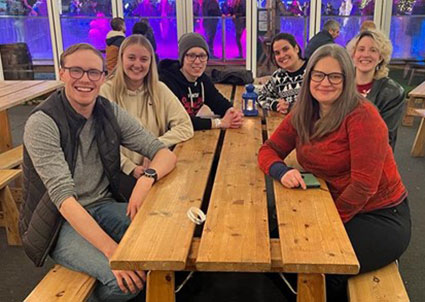
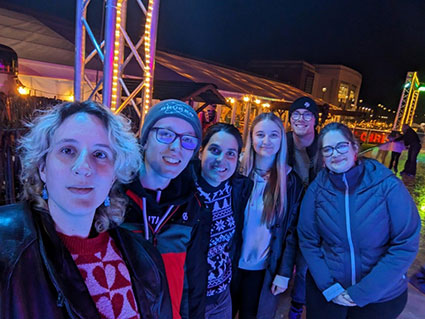
Annual Christmas Skating Party 2022
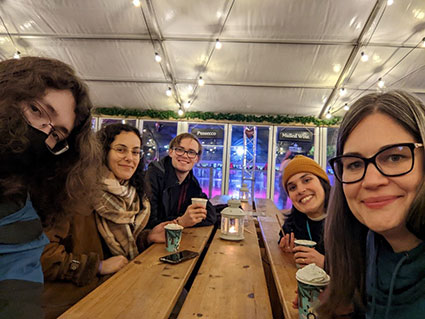
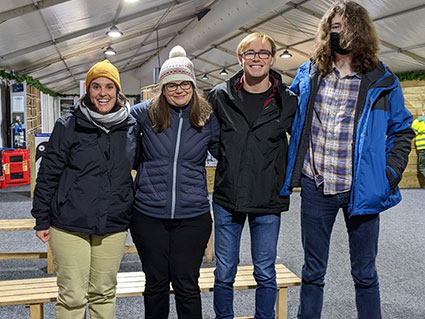
Annual Christmas Skating Party 2021
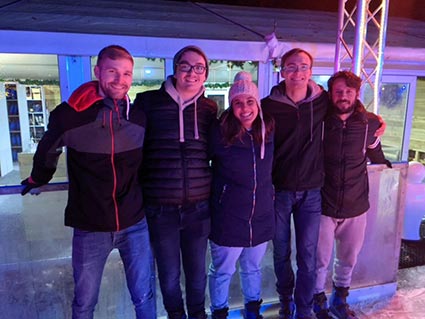
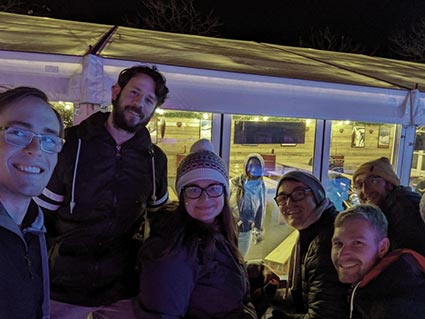
Annual Christmas Skating Party 2019
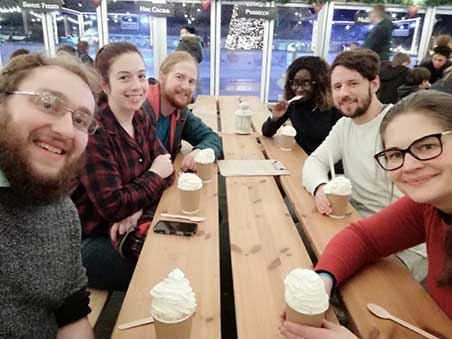
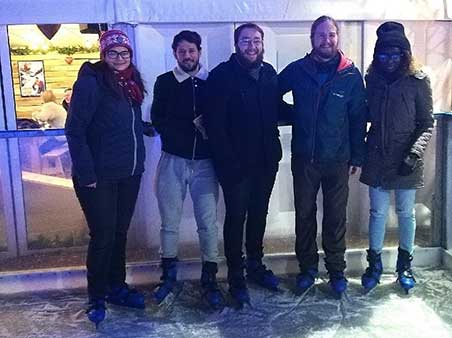
Annual Christmas Skating Party 2018
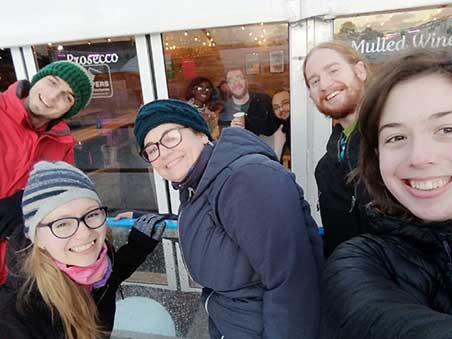
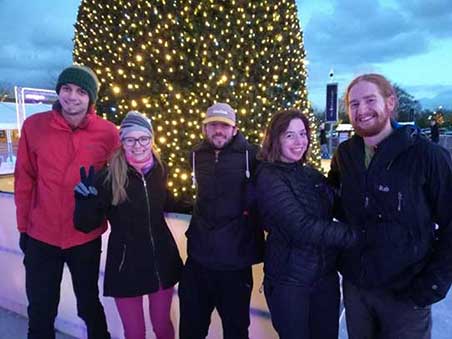
Annual Christmas Skating Party 2017
